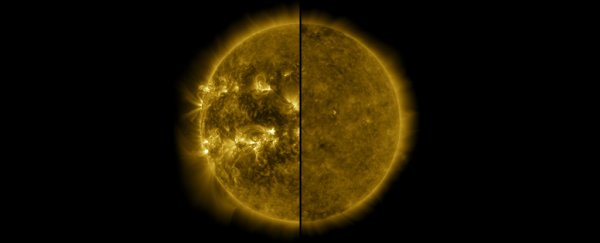Far from the woes of planet Earth, our Sun has been having a rather quiet year. A close look at its activity confirms what solar enthusiasts have been suspecting for a while – our closest star has entered a new cycle.
Ever since we started to track the Sun's dark blemishes in earnest, humans have noticed a pattern of quiescence and temper that repeats roughly every 11 years.
There have been 24 of these cycles since observations were first recorded in the mid-18th century. And, according to a panel made up of experts from NASA and the National Oceanic and Atmospheric Administration (NOAA), December 2019 marked the start of number 25.
You can't be blamed for not noticing the shift. There were no flashes of light, no cosmic trumpets. Just an appearance of low-temperature shadows called sunspots at high latitudes.
"We keep a detailed record of the few tiny sunspots that mark the onset and rise of the new cycle," says Frédéric Clette, director of the World Data Center Sunspot Index and Long-term Solar Observations.
"These are the diminutive heralds of future giant solar fireworks. It is only by tracking the general trend over many months that we can determine the tipping point between two cycles."
In practice, variations in the Sun's behaviour make it impossible to identify a fresh start until it's passed. It took sifting through data on solar activity from the past eight months to confirm last year was as boring as the Sun is going to get for the next decade.
In spite of centuries of careful recording of these 11 year cycles, we still don't have the mechanisms behind these cycles fully worked out. Periodicity in stars is pretty common; looking out into the Universe, there are a variety of pulsating objects that seem to flare and darken at intervals you could almost set your watch by.
The best we can determine for our own Sun's patterns has to do with changes in its magnetic fields, which are in turn driven by complex currents of flowing plasma deep within.
Exactly what pushes and pulls these currents in such a rhythmic way is the part we need to figure out, but there's a temptation to link it with a similar periodicity in planetary orbits.
"As we emerge from solar minimum and approach Cycle 25's maximum, it is important to remember solar activity never stops; it changes form as the pendulum swings," says NASA solar scientist Lika Guhathakurta.
While the cycle of highs and lows takes place over 11 years, it is more accurately a reflection of a larger 22-year cycle defined by a complete overturn in the Sun's polarity. Every 11 years the poles swap, returning to place at the end of the next loop.
Monitoring these transitions can help us better predict space weather, which is dictated largely by outbursts of charged plasma and radiation that can ferociously blow out into space, especially during solar maximums.
It'll be roughly another five years before we can say we're in the thick of the Sun's more aggressive phase. That doesn't mean we needn't be paying attention now.
Whether Solar Cycle 25 will put on a show or not is left to be seen, though is unlikely to be explosive. Number 24 was relatively quiet, after all, but mostly by comparison with preceding cycles which were somewhat stronger than usual.
"Just because it's a below-average solar cycle, doesn't mean there is no risk of extreme space weather," says Doug Biesecker, co-chair of the panel and solar physicist at NOAA's Space Weather Prediction Center in Colorado.
"The Sun's impact on our daily lives is real and is there."
It also pays to be realistic about what that impact is, especially if you're not an astronaut concerned about basking in high-speed protons and X-rays or a space engineer managing a bunch of delicate satellites.
Down here on the surface, shielded by kilometres of atmosphere, solar cycles are barely noticeable. If you're lucky, you might see a slight pick-up in aurora activity during solar maximums; most of the time we don't have to be too concerned about a solar flare destroying life as we know it.
One thing is for sure: any relationship between 2020's rather depressing events and the Sun's pensive mood are at best metaphorical. Still, one can't help but wonder sometimes what the stars are thinking.
